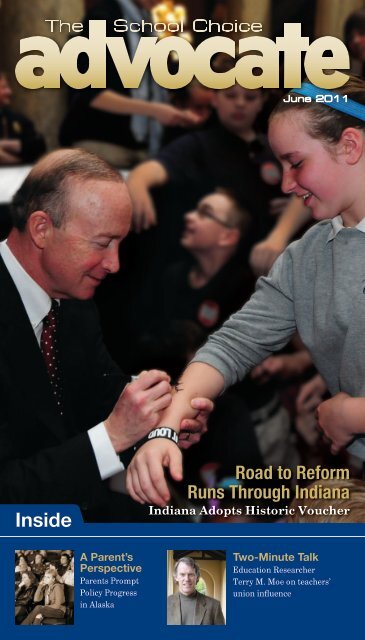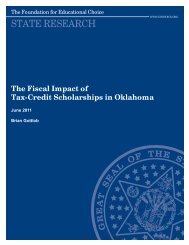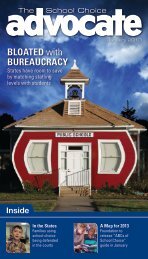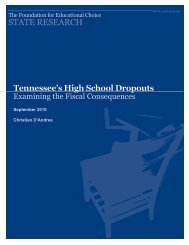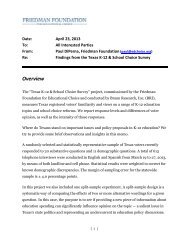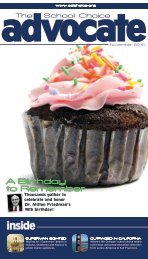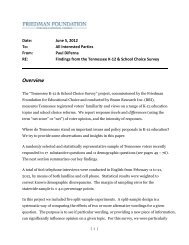Inside - The Friedman Foundation For Educational Choice
Inside - The Friedman Foundation For Educational Choice
Inside - The Friedman Foundation For Educational Choice
You also want an ePaper? Increase the reach of your titles
YUMPU automatically turns print PDFs into web optimized ePapers that Google loves.
June 2011<br />
<strong>Inside</strong><br />
Road to Reform<br />
Runs Through Indiana<br />
Indiana Adopts Historic Voucher<br />
A Parent’s<br />
Perspective<br />
Parents Prompt<br />
Policy Progress<br />
in Alaska<br />
Two-Minute Talk<br />
Education Researcher<br />
Terry M. Moe on teachers’<br />
union influence
President’s Comments<br />
Good Job, But Keep It Going<br />
Robert Enlow<br />
President & CEO<br />
After every victory for school choice, Milton and<br />
Rose <strong>Friedman</strong> used to tell me, “Good job, but the<br />
progress toward universal choice is still too slow.”<br />
Well, this year the progress was not slow. Seven<br />
existing school choice programs have been<br />
expanded and five new voucher and tax credit<br />
programs have been enacted. And we are not done<br />
yet. As of this writing, other states have a chance<br />
to enact new programs or expand existing ones –<br />
Pennsylvania, Wisconsin, Ohio, New Jersey, North<br />
Carolina, Minnesota, and Iowa. Heck, even Texas may finally join the<br />
school choice family.<br />
<strong>The</strong> most exciting news is that school choice is going more universal.<br />
Instead of programs targeting only low-income families, school choice is<br />
breaking in to the middle-income class.<br />
That’s progress. But, as Milton and Rose would remind me, we still have a<br />
long way to go.<br />
In particular, we face two major hurdles. First, we face a challenge from<br />
those who believe that school vouchers should be only for the poor. Dr.<br />
<strong>Friedman</strong> used to say that a program for the poor was a poor program. He<br />
argued that it was the very poor who would benefit most from a universal<br />
voucher program. We must help those less fortunate, but the best way to<br />
reach this goal is by giving everyone a choice. Take cell phones. At the<br />
start, only the rich could afford a cell phone. Now everyone has one, even<br />
the poorest among us. If we approached the cell phone industry in the same<br />
way some approach school choice, I have no doubt that we would have fewer<br />
cell phones for the poor and far less innovation in telecommunications.<br />
Second, we face the challenge of stimulating innovation in the private<br />
school marketplace. It could be argued that private schools are being<br />
discriminated against in terms of access to public funds. Public schools<br />
get 100 percent. Charter schools get around 80 percent or less, and<br />
voucher schools get 70 percent or less. It is difficult to create an effective<br />
marketplace when private schools get less and the incentive for private<br />
capital is to support charter schools.<br />
So, if Milton were alive I have no doubt that he would be pleased with the<br />
progress we made this year. However, I am sure that he would tell me,<br />
“keep it going.”<br />
Dr. Milton <strong>Friedman</strong><br />
Nobel Laureate and Founder<br />
Dr. Rose D. <strong>Friedman</strong><br />
Noted Economist and Founder<br />
BOARD OF DIRECTORS<br />
Dr. Patrick Byrne, Chairman<br />
Chairman of the Board and President, Overstock.com<br />
Gordon St. Angelo, President Emeritus<br />
<strong>For</strong>mer Democratic State Chairman and<br />
Senior Program Officer at Lilly Endowment<br />
Janet F. Martel, Vice Chairperson<br />
Attorney<br />
Lawrence A. O’Connor, Jr., Treasurer<br />
Executive Director, Butler Business Accelerator<br />
Charles H. Brunie<br />
Brunie Associates<br />
Robert C. Enlow<br />
President & CEO<br />
J. Scott Enright<br />
Secretary<br />
Dr. David D. <strong>Friedman</strong><br />
Professor, Santa Clara University<br />
William J. Hume<br />
Chairman of the Board, Basic American, Inc.<br />
Sandra Jordan<br />
Owner, Sandra Jordan Collection<br />
Howard S. Rich<br />
Rich & Rich<br />
Fred Reams<br />
Reams Asset Management<br />
Dr. Michael Walker<br />
President, <strong>The</strong> Fraser Institute <strong>Foundation</strong><br />
STAFF<br />
Dale Buwalda<br />
State Programs & Government Relations Director<br />
Paul DiPerna<br />
Research Director<br />
Carey E. Folco<br />
Vice President of Operations<br />
Leslie D. Hiner<br />
Vice President of Programs & State Relations<br />
Keri Hunter<br />
National Projects Coordinator<br />
Mandy Kett<br />
Office Coordinator<br />
Shepherd Pittman<br />
State Marketing & Public Relations Director<br />
Jeff W. Reed<br />
State Programs & Government Relations Director<br />
Patrick Russell<br />
Development Coordinator<br />
Cindy Sparks<br />
Vice President of External Relations<br />
Andrew St. Angelo<br />
Communications Coordinator/Webmaster<br />
Michelle Stephens<br />
Controller<br />
Drew Vessely<br />
Creative Coordinator<br />
<strong>The</strong> School <strong>Choice</strong> Advocate is published bimonthly<br />
by the <strong>Foundation</strong> for <strong>Educational</strong> <strong>Choice</strong>, a<br />
nonprofit, tax-exempt corporation classified<br />
under section 501(c)(3) of the IRS code. Copies or<br />
subscriptions are free upon request.<br />
Shepherd Pittman<br />
Editor<br />
Drew Vessely<br />
Designer<br />
©<br />
In this Issue<br />
Cover Feature<br />
Road to Reform Runs Through Indiana<br />
Historic Voucher Adopted in Indiana<br />
In Every Issue<br />
President’s Comments<br />
A Parent’s Perspective<br />
<strong>Foundation</strong> News<br />
In the States<br />
Two-Minute Talk<br />
School <strong>Choice</strong> is a Win-Win<br />
Proposition<br />
www.edchoice.org
A Parent’s Perspective<br />
Parents Prompt Policy Progress<br />
in Alaska<br />
<strong>The</strong> Last Frontier State is working to become<br />
the first in the nation to provide universal<br />
school vouchers, and the testimony of families<br />
who have benefited from choice is playing a<br />
crucial role.<br />
A proposal supported by a coalition of<br />
Alaskans, spearheaded by former Anchorage<br />
Mayor Tom Fink, would allow all parents to<br />
choose the best educational setting for their<br />
children. That legislation allows:<br />
• Parents to choose any K-12 education for<br />
their children.<br />
• All state and local funding to follow<br />
students to their schools of choice.<br />
• Any person, business group, church,<br />
or government entity to establish schools,<br />
meeting only health and safety standards.<br />
This is true universal choice for all Alaskan<br />
children.<br />
<strong>The</strong> House Education Committee heard<br />
supportive testimony from 46 Alaskans.<br />
Parents dissatisfied with the public education<br />
system were joined by three school board<br />
members in voicing support for school choice.<br />
Alaskan families also submitted stories to a<br />
website, Alaskans for <strong>Choice</strong> in Education. In<br />
one case, parents removing their child from<br />
traditional public school and enrolling her<br />
in a parent-centered correspondence school<br />
helped that child pursue her musical interests.<br />
Today, she is a studio musician in Los Angeles,<br />
having worked on the “Spider-Man” movie.<br />
Another student’s needs were unmet in public<br />
school. She enrolled in the Family Partnership<br />
Charter School, where she graduated as the<br />
valedictorian. Today she is in her second year<br />
of medical school. <strong>The</strong>se stories, and others,<br />
are driving progress in Alaska.<br />
Because of Alaska’s Blaine Amendment,<br />
the state constitution must be amended to<br />
enact vouchers. A resolution permitting an<br />
amendment passed the House Judiciary<br />
Committee on a 5-2 vote. Next January the<br />
legislature will continue hearings on both bills.<br />
By providing school vouchers to all parents,<br />
reform advocates in Alaska aim to show “the<br />
lower 49” why their state is considered “North<br />
to the Future.”<br />
Alaska families attend a school choice townhall discussion.<br />
<strong>Foundation</strong> News<br />
<strong>The</strong> Year of Growth So Far<br />
Many expected 2011 to be a tremendous year<br />
of growth for school choice. So far the year has<br />
more than lived up to that expectation. This<br />
year, five new school choice programs have<br />
been enacted – a new record.<br />
• Douglas County, Colorado has launched a<br />
voucher program that will allow 500 students<br />
to attend private schools with public funds.<br />
• Arizona created education savings accounts<br />
for children with special needs.<br />
• In Indiana, the nation’s most expansive<br />
voucher law will reach middle-income<br />
families (see our feature story on this<br />
program). <strong>The</strong> state also created a new tax<br />
deduction for families with children<br />
attending private schools.<br />
• Oklahoma now will provide tax credits<br />
to individuals and businesses that donate<br />
to nonprofits that distribute private-school<br />
scholarships to eligible families.<br />
In addition, we have seen seven expansions or<br />
improvements of existing programs.<br />
• Washington, D.C.’s Opportunity Scholarships<br />
program was reauthorized.<br />
• Florida’s McKay Scholarships for children<br />
with special needs was expanded to include<br />
all children with essentially any identified<br />
special need.<br />
• Indiana’s tax-credit scholarship program<br />
increased the total cap on available donations<br />
to $5 million.<br />
• Georgia’s tax-credit scholarships were<br />
expanded.<br />
It is an exciting time for supporters of school<br />
choice. <strong>The</strong> <strong>Foundation</strong> is grateful for your<br />
support, encouragement, and hard work as<br />
you partner with us to continue advocating for<br />
families’ freedom to choose the best education<br />
for their children.<br />
www.edchoice.org
Cover Feature<br />
Road to Reform Runs<br />
Historic Voucher Adopted in Indiana<br />
by <strong>Foundation</strong> Staff<br />
ndiana is known as the “Crossroads of<br />
I America.” A vast network of highways runs<br />
through the state carrying people and goods<br />
literally from “sea to shining sea.” In one<br />
sense, it could be said that if you really want to<br />
go anywhere you have to go through Indiana.<br />
<strong>The</strong> same now can be said of the highways<br />
of education reform. Thanks to Gov. Mitch<br />
Daniels and many courageous legislators, all<br />
education reform roads now come through “the<br />
Crossroads” of Indiana.<br />
In 2011, Indiana passed the most comprehensive<br />
set of systemic education reforms ever seen<br />
nationwide. Collective bargaining was limited<br />
to wages and benefits only. <strong>The</strong> practice of<br />
laying off teachers with the least seniority first<br />
regardless of their competence was ended.<br />
A teacher and principal evaluation system<br />
was created that will pay teachers based on<br />
quality, not length of service. Charter and<br />
virtual schools were dramatically expanded<br />
and the school funding formula was changed<br />
to ensure money follows kids.<br />
In addition to all this, Indiana passed<br />
what will likely become the nation’s<br />
largest school voucher<br />
program.<br />
New Voucher Program Created<br />
On May 5, Gov. Daniels signed into law HB<br />
1003, the School Scholarship Act. After signing<br />
the bill, which will have the broadest eligibility<br />
of any voucher program in the nation, he sealed<br />
it with a kiss.<br />
Here’s what makes it unique: Eligibility for<br />
the new voucher program is set at 150 percent<br />
of the federal Free and Reduced Price Lunch<br />
program. Stretching well into the middle class,<br />
the program allows a family of four earning<br />
up to $62,000 per year to receive a voucher<br />
to attend the private school of their choice.<br />
Uniquely, the program is not limited to students<br />
with special needs, students attending failing<br />
schools, or those residing within a particular<br />
municipality. Any family in the state whose<br />
child has previously attended public schools<br />
and falls within the broad income requirements<br />
is eligible—period. <strong>For</strong> the first time in modern<br />
history, the public will have the opportunity to<br />
observe real market forces at work and see the<br />
effects that a broad school choice program can<br />
have on the landscape of American education.<br />
This victory was possible in large part because<br />
of Gov. Daniels, who is an outspoken supporter<br />
of school choice. In his 2011 State of the State<br />
address, Gov. Daniels declared, “We must begin<br />
to honor the parents of Indiana. We must trust<br />
them, and respect them enough, to decide when,<br />
where, and how their children can receive the<br />
best education, and therefore the best chance<br />
in life…. <strong>For</strong> families who cannot find the right<br />
traditional public school, or the right charter<br />
public school for their child, and are not wealthy<br />
enough to move near one, justice requires that<br />
we help. We should let these families apply<br />
dollars that the state spends on their child to the<br />
non-government school of their choice.”<br />
www.edchoice.org
Through Indiana<br />
Thus, the voucher legislation became a<br />
cornerstone of Gov. Daniels’ education reform<br />
agenda. Strong support and leadership from<br />
Superintendent of Public Instruction Tony<br />
Bennett, Senate President David Long, and<br />
Speaker of the House Brian Bosma, enabled<br />
the passage of the School Scholarship Act,<br />
dramatically expanding educational options in<br />
Indiana.<br />
Importantly, this historic legislation goes further<br />
than just creating a new voucher program. <strong>The</strong><br />
bill also expands Indiana’s existing tax-credit<br />
scholarship program and creates a new personal<br />
tax deduction for educational expenses for<br />
families with children in private school.<br />
Tax-Credit Scholarship<br />
Program Expanded<br />
Indiana lawmakers also doubled the preexisting<br />
cap on the state’s tax-credit scholarship program<br />
to $10 million from $5 million in available<br />
scholarships. Moreover, onerous restrictions<br />
that slowed the growth and implementation of<br />
the tax-credit program were removed, clearing<br />
the way for more robust growth in the program.<br />
<strong>The</strong> increased cap, coupled with common sense<br />
reforms to the rules governing the program, will<br />
result in even more families being able to choose<br />
the school that best meets their children’s needs.<br />
Role of the <strong>Foundation</strong><br />
Throughout the last five years, the <strong>Foundation</strong><br />
has played a critical role in Indiana. We have<br />
provided literally over 1,000 unique program<br />
services to educate the public and policymakers.<br />
As State Rep. Cindy Noe stated following the<br />
choice measure’s passage, the <strong>Foundation</strong> has<br />
been “...the cavalry through all of this from<br />
the beginning. <strong>The</strong>y were the germinators of<br />
ideas and then they put the thought, people<br />
and resources behind it to see these ideas come<br />
to fruition…. <strong>The</strong>y have put the focus on the<br />
children and what is best for them.”<br />
In 1998, Nobel Laureate Milton <strong>Friedman</strong><br />
wrote, “We have so far only seen the early fruits<br />
from the introduction of vouchers, from giving<br />
parents a choice. <strong>The</strong> best is yet to come.”<br />
Today, Milton <strong>Friedman</strong>’s vision for school<br />
choice is becoming a reality across the country.<br />
Thanks to the leadership of Gov. Daniels and<br />
so many others, Indiana has paved the road to<br />
additional bold reforms throughout the nation.<br />
New Personal Tax Deduction Created<br />
<strong>The</strong> legislation also created a $1,000 tax<br />
deduction for private and home school families.<br />
<strong>The</strong> new deduction has universal eligibility and<br />
applies to any approved expenditure, including<br />
tuition. With the addition of the tax deduction,<br />
there is truly something for everyone in the<br />
Hoosier state when it comes to educational<br />
options, public or private.<br />
From left: Indiana parent Randy Duke, Russ Simnick, president of the<br />
Indiana Public Charter Schools Association, and Robert Enlow, president<br />
of the <strong>Foundation</strong> for <strong>Educational</strong> <strong>Choice</strong>, join Gov. Mitch Daniels and<br />
Lt. Gov. Becky Skillman for Indiana’s historic bill signing on May 5, 2011.<br />
www.edchoice.org
In the States<br />
School <strong>Choice</strong> is a<br />
Win-Win Proposition<br />
by Greg <strong>For</strong>ster<br />
In early 2011 I wrote an article headlined<br />
“School <strong>Choice</strong> Is Back!” Now, just a few<br />
months later, even that feels like too little.<br />
School choice is explosive this year. It’s a top<br />
issue in at least half a dozen states, and we’re<br />
seeing legislative breakthroughs that surpass<br />
anything the movement has seen before.<br />
Naturally, with this policy revolution underway,<br />
people want to know whether school choice<br />
provides a better education, and how it affects<br />
public schools. <strong>For</strong>tunately, there’s a large body<br />
of evidence on this question, and it consistently<br />
favors vouchers.<br />
To make sure the public hears about this<br />
evidence and not just the unfounded claims of<br />
the teachers’ unions, this March the <strong>Foundation</strong><br />
released A Win-Win Solution: <strong>The</strong> Empirical<br />
Evidence on School Vouchers. In this report, I<br />
provide a comprehensive overview of scientific<br />
research on the effects of vouchers. It’s a revised<br />
and expanded edition of the report, adding new<br />
topics and more recent studies.<br />
Currently, there are 26 school choice programs<br />
in 16 states and Washington, D.C. Through these<br />
programs, more than 190,000 students attend<br />
private schools using public funds. Researchers<br />
at Harvard, Princeton, Stanford, Cornell,<br />
the Federal Reserve Bank, the University of<br />
Florida, the University of Arkansas and other<br />
institutions have studied these programs using<br />
high-quality empirical methods.<br />
<strong>The</strong> data consistently show that school choice<br />
provides a better education to those who use it.<br />
Ten studies have examined this question using<br />
“random assignment,” the gold standard of<br />
social science research. <strong>The</strong>se studies compare<br />
students who got vouchers to students who<br />
applied for vouchers but weren’t offered them<br />
because of a random lottery – providing for<br />
the perfect treatment and control groups. <strong>The</strong><br />
studies consistently show positive impacts from<br />
vouchers. No empirical study has ever found a<br />
negative effect.<br />
<strong>The</strong> data also show that choice improves public<br />
schools. You can’t do random assignment<br />
studies on public schools, but there are<br />
plenty of studies on this question using other<br />
methods. Of the 19 studies conducted, 18 find<br />
a positive effect on public schools. One study<br />
finds no effect – and that’s in the D.C. voucher<br />
program, which insulates public schools from<br />
the effects of competition. As with the effects<br />
on participants, no study has ever found that<br />
school choice had a negative impact on public<br />
schools.<br />
<strong>The</strong>se results aren’t hard to explain. Putting<br />
parents in charge of the system creates the<br />
healthy incentives that schools need to sustain<br />
improvements in performance.<br />
In fact, the evidence for vouchers is so<br />
overwhelming that when voucher opponent<br />
Jay Mathews covered my Win-Win report<br />
for the Washington Post, he freely admitted<br />
that vouchers deliver a better education and<br />
improve public schools to boot. <strong>The</strong> only excuse<br />
he could come up with to oppose vouchers was<br />
that they supposedly aren’t politically viable.<br />
Well, the legislative record since then speaks<br />
for itself. After Jay’s article ran, I offered to bet<br />
him a fancy dinner based on how well voucher<br />
bills do this year. We settled on a threshold of<br />
seven new or expanded programs this year as<br />
the goal school choice has to meet. As of this<br />
writing, it looks like vouchers will pass that<br />
mark in a walk.<br />
And the programs that are passing aren’t just<br />
any programs. Indiana has enacted what will<br />
be the nation’s largest program ever. Arizona<br />
has enacted the first ever “education savings<br />
accounts” – a new form of school choice that<br />
holds tremendous promise for creating even<br />
more direct parental control over tuition<br />
dollars. And in Wisconsin, Gov. Scott Walker<br />
is pushing to make the Milwaukee voucher the<br />
nation’s first truly universal choice program.<br />
When I win, Mathews has to buy me dinner in<br />
Milwaukee. I wonder if any of the restaurants<br />
there serve crow.<br />
Greg <strong>For</strong>ster is a senior fellow at the<br />
<strong>Foundation</strong> for <strong>Educational</strong> <strong>Choice</strong>.<br />
To read the 2011 Win-Win study, visit<br />
www.Ed<strong>Choice</strong>.org/WinWin2011.<br />
To request a free copy, email<br />
info@edchoice.org or call (317) 681-0745.<br />
www.edchoice.org
Two Minute<br />
TALK<br />
Terry M. Moe<br />
Education Researcher<br />
TALK<br />
If you had to sum up the impact of teachers’<br />
unions on American K-12 education, what<br />
would you say?<br />
<strong>The</strong> teachers’ unions are the most powerful groups<br />
in American education, and they use their power<br />
to promote the job interests of their members<br />
rather than what is best for kids and schools.<br />
In collective bargaining, they impose restrictive<br />
work rules that lead to bizarre, ineffective forms<br />
of organization. In the political process, they block<br />
school choice and other reforms that they find<br />
threatening, regardless of how beneficial those<br />
reforms might be. All of this has been going<br />
on for a quarter century, and helps explain why<br />
this nation has largely failed to bring significant<br />
improvement to the public schools.<br />
How did unions come to such a position<br />
of influence?<br />
Prior to 1960, very few teachers belonged to<br />
unions and collective bargaining was virtually<br />
nonexistent in American education. But during<br />
the 1960s and ’70s, many states adopted laws<br />
to promote collective bargaining for public sector<br />
workers, and this ignited an explosion of union<br />
organizing among teachers. When the dust finally<br />
settled in the early 1980s, virtually all districts<br />
of any size (outside the South) were organized,<br />
collective bargaining was the norm, and the<br />
teachers’ unions—with millions of members,<br />
tons of money, and thus formidable resources<br />
for political action—reigned supreme as the most<br />
powerful force in American education.<br />
Is there light at the end of the tunnel?<br />
In the near term, the unions will remain powerful—<br />
because they can normally use their power to<br />
block reformist efforts to take their power away.<br />
Two emerging developments, however, will<br />
drastically reduce their power over the long term.<br />
One is that the political tides are shifting against<br />
them, even among Democrats. <strong>The</strong> second<br />
is that information technology is destined to<br />
revolutionize public education—greatly reducing<br />
the number of teachers (and union members) per<br />
student, proliferating virtual options to the regular<br />
(unionized) schools, and more. <strong>The</strong> combination<br />
of politics and technology will eventually prove<br />
crippling to union power.<br />
Resources for Reform<br />
Looking to dig deeper into education reform?<br />
Two new books, both by contributors to this<br />
issue of <strong>The</strong> School <strong>Choice</strong> Advocate, shed light<br />
on the path to educational choice – and the<br />
roadblocks standing in the way. Both books are<br />
available at Amazon.com.<br />
Special Interest<br />
by Terry M. Moe<br />
Why, after a quarter century<br />
of costly reform, have<br />
America’s schools proved so<br />
difficult to improve? In this<br />
landmark book, Terry M.<br />
Moe demonstrates that the answer has a great<br />
deal to do with the teachers’ unions—which, as<br />
the most powerful forces in American education,<br />
relentlessly advance and protect their job-related<br />
interests at the expense of children and schools.<br />
Despite their importance, the teachers’ unions<br />
have barely been studied. Special Interest fills<br />
that gap with an analysis of their historical rise<br />
to power, the organizational foundations of<br />
that power, the ways it is exercised in collective<br />
bargaining and politics, and its vast consequences<br />
for American education. <strong>The</strong> bottom line is<br />
simple but devastating: As long as the teachers’<br />
unions remain powerful, the nation’s schools<br />
will never be organized to provide kids with the<br />
most effective education possible.<br />
Anyone who hopes to understand American<br />
education, its reform—and its serious problems—<br />
needs to read this book. It is an eye-opener.<br />
Freedom and School<br />
<strong>Choice</strong> in American<br />
Education<br />
Edited by Greg <strong>For</strong>ster<br />
and C. Bradley Thompson<br />
In Freedom and School<br />
<strong>Choice</strong> in American<br />
Education, leading school reform intellectuals<br />
outline their visions for the future of the<br />
movement to improve schools through<br />
competition and choice. Each author outlines<br />
a distinct perspective on the goal of choiceoriented<br />
reform and the best means for achieving<br />
it. Because the authors agree on the value of<br />
parental choice, they are able to avoid repeating<br />
all the old familiar debates that everyone has<br />
already encountered. Instead, this volume takes<br />
the reader inside the movement to empower<br />
parents with choice, airing the more interesting<br />
debates that the reformers have with one another<br />
over the direction and strategy of their movement.<br />
<strong>The</strong> authors are prominent figures and represent<br />
most of the key national institutions in the<br />
movement, so these debates are central to the<br />
school choice movement’s future.<br />
www.edchoice.org
One American Square • Suite 2420<br />
Indianapolis, IN 46282<br />
Change Service Requested<br />
“We have so far only seen the early fruits from<br />
the introduction of vouchers, from giving parents<br />
a choice. <strong>The</strong> best is yet to come as competition<br />
and the market work their wonders.”<br />
Milton <strong>Friedman</strong>, from <strong>The</strong> School <strong>Choice</strong> Advocate in 1998.


